Overview
This article presents a comprehensive, step-by-step guide on successfully integrating legacy systems, tackling key challenges while offering effective strategies and tools for organizations. It underscores the critical nature of assessment, objective definition, and the implementation of integration technologies such as APIs and middleware. By illustrating how a structured approach can significantly enhance operational efficiency, the article reinforces the importance of ensuring the longevity of legacy systems in modern environments. Are you ready to transform your legacy systems into assets that drive success?
Introduction
In a rapidly evolving digital landscape, legacy systems serve as the backbone of numerous organizations, particularly in critical sectors such as banking and healthcare. While these outdated technologies are essential for day-to-day operations, they present unique challenges as businesses endeavor to modernize and integrate them with contemporary solutions. The urgency to address compatibility issues, security vulnerabilities, and escalating maintenance costs is palpable.
Industries are facing increasing demands for efficiency and innovation, making this a pressing concern. With the global digital banking market projected to reach an astounding $22.3 trillion by 2026, the need for effective integration strategies has never been more critical.
This article delves into the complexities of legacy system integration, exploring the obstacles organizations encounter, the tools and technologies available to facilitate this process, and best practices to ensure successful outcomes. As companies navigate this intricate journey, understanding how to leverage legacy systems as both challenges and assets will be crucial for future success.
Understanding Legacy Systems: Definition and Importance
Legacy networks represent outdated computing infrastructures, software applications, or technologies that, despite their age, continue to play a crucial role in the operations of many organizations, particularly in sectors like banking and healthcare. These frameworks often support essential functions, managing critical data and processes necessary for daily operations. However, integrating legacy systems into modern environments poses significant challenges, including compatibility issues, security vulnerabilities, and escalating maintenance costs.
The importance of these older platforms cannot be overstated, especially as organizations navigate the complexities of digital transformation. In 2025, a staggering 87% of health organization leaders anticipate heightened demands for revenue cycle management (RCM) upgrades, underscoring the urgent need for effective integration strategies. Moreover, the global digital banking market is projected to reach $22.3 trillion by 2026, growing at a compound annual growth rate (CAGR) of 8.5%. This growth emphasizes the necessity for banks to modernize their outdated frameworks to remain competitive and responsive to evolving market demands.
Real-world examples illustrate the impact of antiquated structures on operational efficiency. For instance, organizations are increasingly seeking ways to enhance the patient financial experience through improved price transparency and technology utilization. Successful outcomes from these initiatives highlight the potential for better communication and engagement, particularly through mobile platforms and AI-driven support.
Avato’s hybrid integration platform simplifies these complex integration projects, enabling organizations to quickly and effectively enhance the value of their legacy systems while reducing costs. The platform also provides real-time monitoring and alerts on performance, ensuring that organizations maintain peak operations.
Expert insights further emphasize the vital role of outdated frameworks in banking and healthcare. Val Srinivas, a senior research leader in Banking & Capital Markets, points out that while these systems can impede modernization efforts, they also harbor a wealth of data and functionality that, if leveraged correctly, can spur innovation. As organizations strategize for modernization, integrating legacy systems while recognizing their dual nature—as both a challenge and a resource—will be essential for successful unification efforts in 2025 and beyond.
The solutions provided by Avato are tailored to address these challenges, reflecting a deep commitment to developing the technological infrastructure necessary for modernizing operations and enhancing customer experiences.
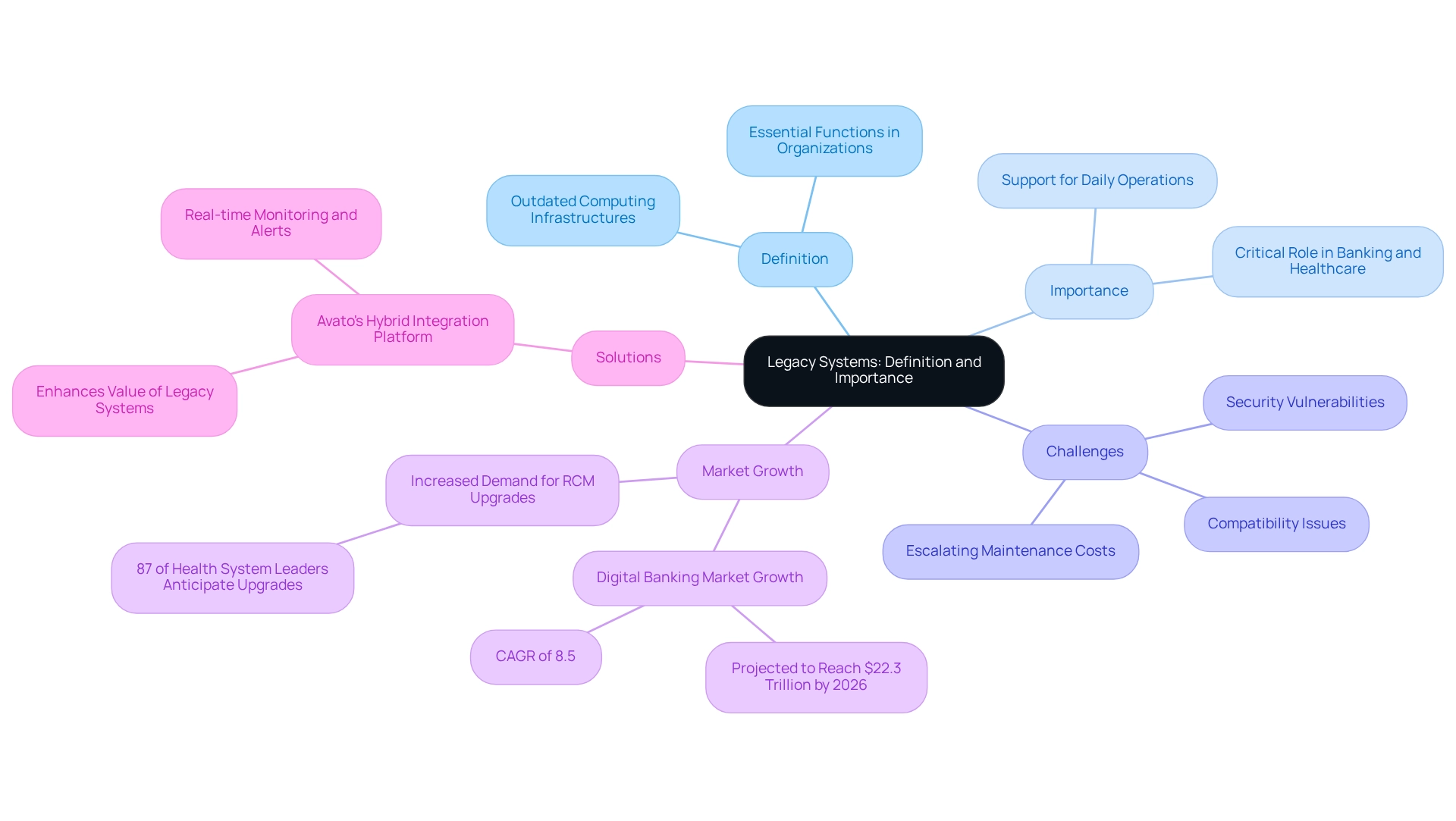
Challenges of Legacy System Integration: Key Obstacles to Overcome
Integrating legacy systems presents several significant challenges that organizations must navigate. However, with Avato’s dedicated hybrid integration platform, these challenges can be effectively addressed:
- Data Incompatibility: A staggering 55% of businesses cite scalability as a key factor in their IT strategy. Integrating legacy systems often involves obsolete data formats that conflict with contemporary applications, leading to separated data silos that obstruct efficient decision-making and operational effectiveness. The hybrid platform streamlines this process by facilitating seamless data connectivity, enabling companies to access isolated assets and enhance their operational capabilities.
- Security Risks: Outdated technologies frequently lack the robust security features essential for protecting sensitive information, rendering them vulnerable to cyber threats. As industries increasingly adopt AI and automation, addressing these security vulnerabilities becomes paramount. Avato’s integration solutions are designed with security in mind, ensuring that sensitive data is safeguarded throughout the integration process.
- High Maintenance Costs: The financial burden of maintaining outdated infrastructure can be substantial. Organizations often face rising expenses due to the demand for specialized skills and the likelihood of recurring failures, which can disrupt business continuity and affect overall productivity. By integrating legacy systems through a hybrid connectivity platform, companies can lower these expenses with more effective unification strategies that reduce the need for considerable upkeep.
- Limited Scalability: Legacy infrastructures generally do not accommodate the scalability necessary for contemporary business operations. This limitation can stifle growth and innovation, making it challenging for organizations to adapt to evolving market demands and technological advancements. Avato enables businesses to future-proof their operations by integrating legacy systems with new tools, ensuring scalability and adaptability.
- Lack of Documentation: Many legacy systems were developed without adequate documentation, complicating efforts to understand their architecture and functionality. This absence of clarity can result in inefficiencies and heightened risk during the integration of legacy systems. Avato’s team of specialists offers essential assistance to manage these complexities, ensuring a smoother merging process.
Addressing these challenges requires a strategic approach to integrating legacy systems. For instance, determining whether an inherited framework requires connection or complete modernization entails analyzing its performance, security, and maintenance expenses in relation to present business needs. If a framework hardly meets these criteria, combining may suffice; however, complete modernization is crucial if the setup is outdated, inefficient, or excessively expensive to maintain.
The case study titled “Assessing Legacy System Needs” illustrates this approach, emphasizing the importance of comparing a system’s performance and costs to current business requirements.
Expert insights highlight that advancements in technology will likely drive greater adoption in sectors historically resistant to change. Omer Nasir, Director of Engineering at Tkxel, observes that organizations can attain a 30% enhancement in operational efficiency by updating applications, underscoring the potential advantages of addressing connectivity challenges. Furthermore, to succeed in overcoming technical debt and effectively adopting AI and automation, industries need a holistic approach that addresses broader organizational and resource-related challenges.
Organizations that successfully tackle these integration obstacles can unlock significant operational efficiencies, as evidenced by case studies demonstrating successful projects that have led to improvements in performance and cost-effectiveness.
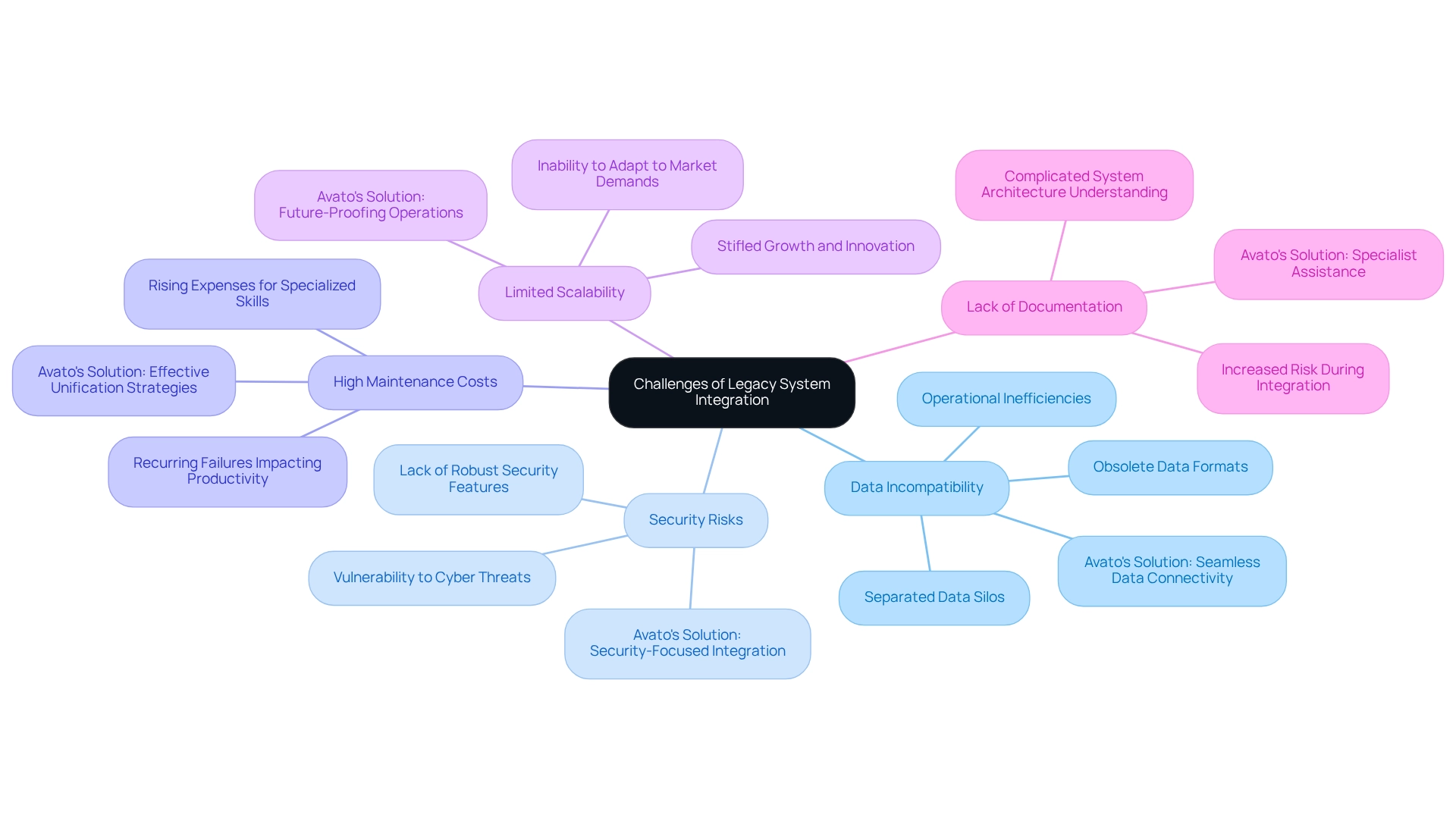
Integration Strategies: Effective Approaches for Legacy Systems
To efficiently incorporate older infrastructures, consider the following strategies:
-
API Integration: Utilize APIs to create a seamless link between outdated frameworks and contemporary applications. This approach facilitates efficient data exchange, enabling organizations to enhance operational workflows and improve service delivery. Remarkably, API incorporation has demonstrated success rates surpassing 70% in legacy platforms, highlighting its efficiency in connecting old and new technologies. Avato’s Hybrid Integration Platform further enhances this value by streamlining the connection process, enabling real-time monitoring and alerts on performance.
-
Middleware Solutions: Implement middleware to streamline communication between disparate systems. Middleware acts as a translator, ensuring that data flows smoothly across platforms, which is crucial for maintaining operational continuity. Based on industry insights, middleware solutions can reduce documentation time by more than a third, significantly speeding up connection processes. This efficiency is vital as organizations strive to meet their digital transformation objectives; BCG reports that only 35% of businesses have successfully achieved their goals in this area. Avato’s platform improves this by offering a strong framework for managing complex connections effortlessly.
-
Phased Migration: Instead of executing a complete overhaul, consider a phased migration approach. Slowly changing elements of the old framework reduces disruption and enables improved risk management. This strategy is particularly beneficial in regulated environments, where integrating legacy systems while maintaining compliance is paramount. Avato’s Hybrid Integration Platform facilitates this method by allowing organizations to enhance the worth of their older technologies while maintaining security and ease in intricate environments.
-
Data Transformation: Utilize data transformation tools, such as XSLT, to convert outdated data into formats compatible with modern systems. XSLT, being a highly-tuned declarative programming language, eliminates significant labor in creating transformative tasks for XML data structures. This guarantees data integrity during the incorporation process, enabling organizations to leverage valuable insights from their historical data without sacrificing quality. The cost-saving benefits of schemas in data management further enhance this process, reducing programming errors and associated costs.
-
Cloud Solutions: Explore the option of moving outdated applications to the cloud. This transition can enhance scalability, reduce maintenance costs, and improve accessibility. As organizations encounter an expanding skills gap in cloud computing and data analytics—indicated by 54% of IT professionals—utilizing cloud solutions can also streamline the incorporation of advanced technologies. The adoption of composable enterprise strategies will allow companies to adapt applications and services rapidly by 2030, making cloud solutions even more relevant. Avato’s platform supports this shift, guaranteeing that outdated infrastructures can be combined with contemporary cloud applications efficiently.
By implementing these approaches, organizations can adeptly manage the challenges of integrating legacy systems, ensuring they remain competitive in a constantly changing digital environment. A real-world example of successful unification can be seen in the efforts of Ludovic Fourrage, founder of Nucamp, who has effectively utilized unification strategies to enhance educational technology, demonstrating the potential for success across various sectors.

Tools and Technologies for Legacy System Integration: What You Need to Know
The process of integrating legacy systems can be optimized through an array of sophisticated tools and technologies aimed at improving connectivity and efficiency. Several key solutions stand out in 2025:
-
The Hybrid Connection Platform: This platform empowers organizations to enhance and prolong the value of older setups while streamlining intricate connections. It provides real-time oversight and notifications regarding performance, significantly lowering expenses related to connection projects. This is particularly beneficial for financial institutions seeking to modernize their IT infrastructure by integrating legacy systems without extensive overhauls. By utilizing the platform, banking IT managers can achieve substantial cost reductions while ensuring a smooth connection of their existing systems.
-
Integration Platform as a Service (iPaaS): While solutions like MuleSoft and Dell Boomi offer cloud-based platforms that streamline connections between outdated technologies and contemporary applications, the Hybrid Integration Platform from Avato distinguishes itself by providing a customized approach specifically designed for the financial sector. This ensures that organizations can modernize their IT infrastructure effectively and efficiently.
-
Enterprise Service Bus (ESB): Tools such as Apache Camel and WSO2 ESB play a crucial role in facilitating communication between disparate applications. Avato’s platform enhances this capability by ensuring that integrating legacy systems allows for efficient and secure data exchange—vital for financial institutions.
-
Data Integration Tools: ETL (Extract, Transform, Load) tools, including Talend and Informatica, are essential for transferring and transforming data from older setups to modern databases. Ongoing code quality assessments within these tools bolster the security and reliability of updated frameworks, particularly when integrating legacy systems, ensuring data integrity is preserved throughout the process.
-
API Management Tools: Solutions like Apigee and AWS API Gateway enable organizations to oversee and safeguard APIs that connect outdated infrastructures with modern applications. Effective API management is critical for streamlining services and enhancing connectivity, especially in environments where user experience, security features, and performance monitoring are paramount to protect against potential breaches.
-
Monitoring Tools: Implementing monitoring solutions such as New Relic or Datadog is crucial for tracking the performance of integrated networks. These tools guarantee that all elements function seamlessly, offering immediate insights that assist organizations in swiftly resolving any emerging issues.
As organizations continue to navigate the challenges of unifying older platforms, integrating legacy systems with Avato’s Hybrid Connectivity Platform will be essential for maintaining competitiveness and enhancing user experience. The ongoing trend towards application modernization underscores the importance of this integration to adopt new technologies and remain relevant in a rapidly evolving digital landscape. Avato simplifies complex projects and delivers results within desired time frames and budget constraints, further validating the effectiveness of its integration solutions.
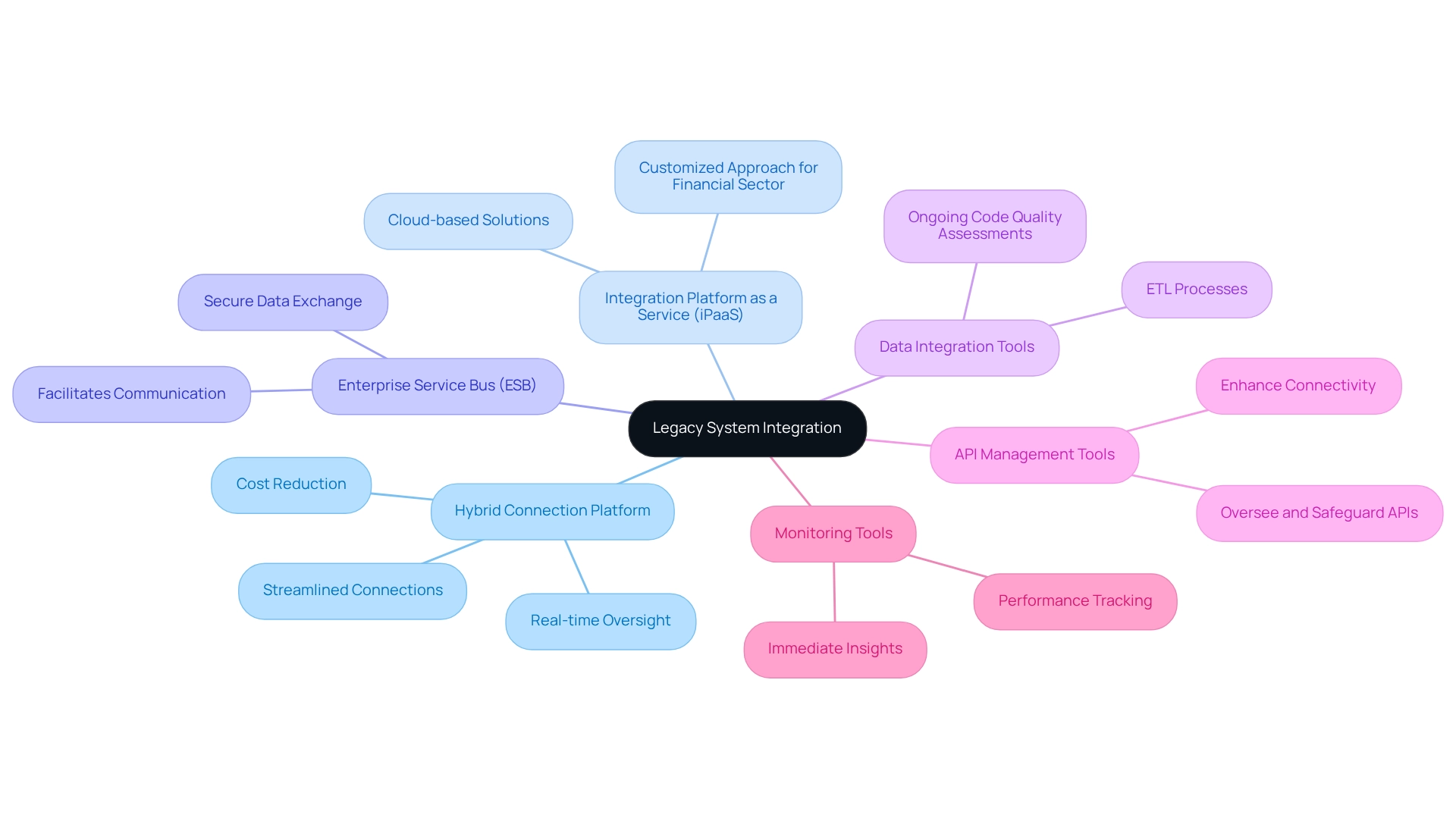
Step-by-Step Guide to Integrating Legacy Systems: A Practical Approach
To effectively integrate legacy systems, follow this structured step-by-step guide:
-
Assessment: Begin by thoroughly evaluating the existing legacy systems. Comprehend their architecture, data structures, and connection capabilities. This essential step is vital as it assists in recognizing possible challenges and opportunities for unification.
-
Define Objectives: Clearly articulate the goals of the unification project. This includes specifying which systems need to be connected and the expected outcomes. For instance, organizations should aim to enhance data accessibility or improve operational efficiency. Establishing these objectives in advance is crucial for directing the merging process.
-
Choose Unification Approach: Based on the evaluation and established objectives, select the most suitable unification strategy. This could involve methods such as point-to-point connections, middleware solutions, or API-based interactions, depending on the complexity and requirements of the systems involved.
-
Select Tools: Identify and acquire the necessary tools and technologies that correspond with your chosen incorporation strategy. Leveraging XSLT, for example, can significantly streamline XML data transformation and reduce programming errors, leading to substantial cost savings. The right tools can enhance the overall effectiveness of the project.
-
Implementation: Begin the unification process with a pilot project. This allows for testing the integration approach on a smaller scale before full deployment, minimizing risks and enabling adjustments based on initial findings.
-
Testing: Conduct comprehensive evaluations to ensure that the integrated setups function as intended. Confirm that information moves accurately between platforms and that all features fulfill the established goals. This step is critical to avoid disruptions in operations post-deployment.
-
Deployment: Finally, roll out the implementation across the organization. Ensure that all stakeholders are informed and sufficiently trained on the new processes. Effective communication and training are essential to ensure a smooth transition and optimize the advantages of the merger.
A significant illustration of successful unification can be observed in the efforts with Coast Capital, where the hybrid solution facilitated major system transitions with minimal downtime, highlighting the transformative effect of the platform on financial institutions. Furthermore, Gustavo Estrada, a customer, emphasizes Avato’s capability by stating, “Avato simplifies complex projects and delivers results within desired time frames and budget constraints.” This emphasizes the effectiveness of a structured unification approach.
However, organizations must also be aware of common challenges in implementing data-driven decision-making, such as data silos and poor data quality, which can obstruct unification efforts. By adhering to these optimal methods, organizations can effectively manage the intricacies involved in integrating legacy systems and accomplish their unification objectives.
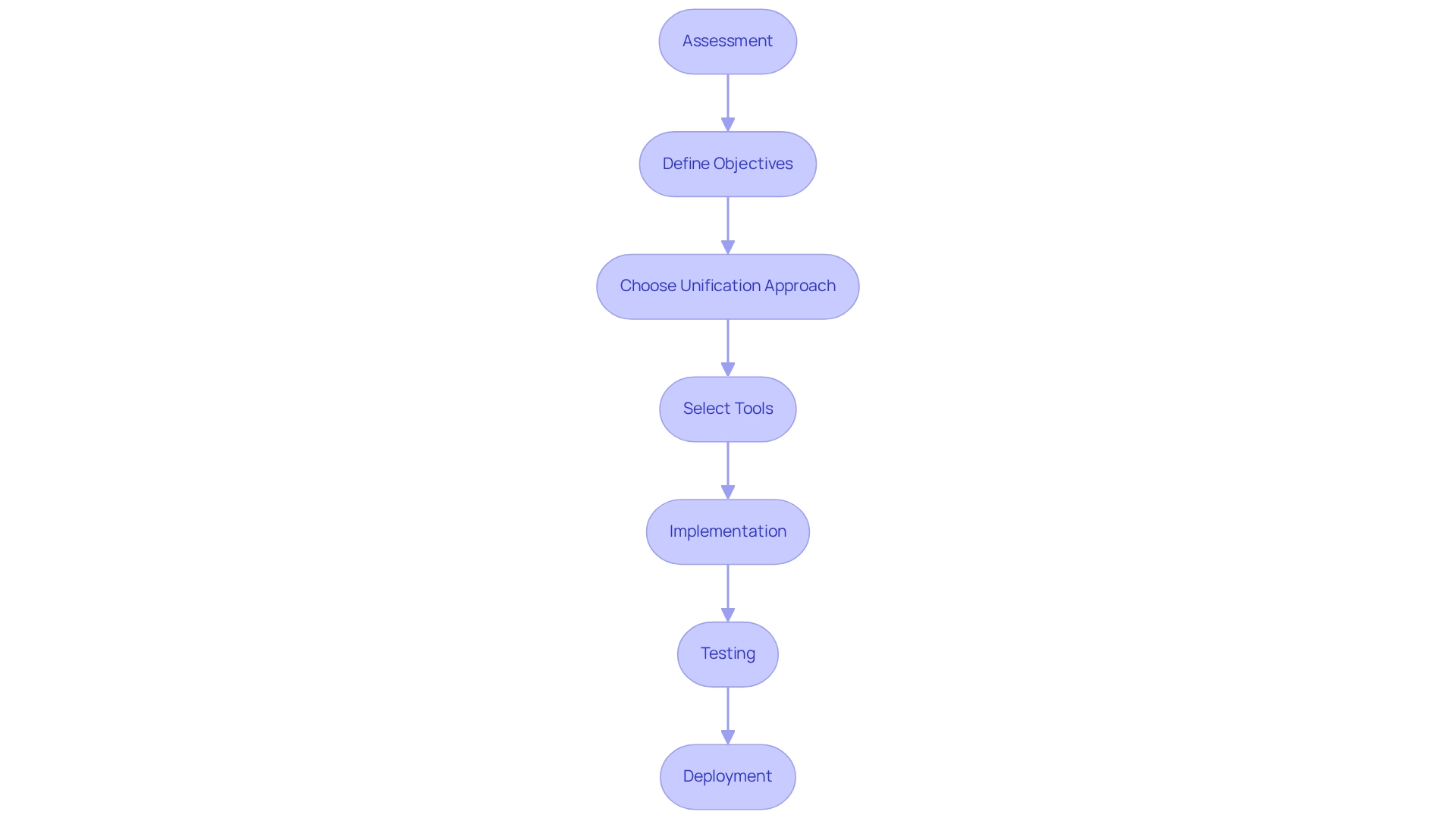
Testing and Monitoring: Ensuring Successful Integration Outcomes
To guarantee successful results in incorporating technology, particularly in the banking sector, it is essential to implement robust testing and monitoring practices that effectively address the challenges of integrating legacy systems. Avato’s dedicated hybrid unification platform is meticulously designed to simplify these challenges and enhance business value. Here are key strategies to consider:
-
Unit Testing: Initiate the process by testing individual components of the integration. This crucial step confirms that each component operates correctly before full deployment, thereby reducing the risk of errors in the integrated setup. Avato’s platform supports this process by providing tools that facilitate thorough unit testing.
-
Combining Tests: Conduct comprehensive combining tests to evaluate how effectively the components function together. Focus on data flow and functionality to ensure seamless interaction between legacy systems and contemporary infrastructures. The architecture of this system is designed for secure transactions, making it particularly efficient in environments where integration failures can have serious consequences.
-
User Acceptance Testing (UAT): Engage end-users in the testing process to verify that the integrated solutions meet their needs and expectations. Success rates in UAT have been shown to improve when users are actively involved, leading to higher satisfaction and adoption rates post-integration. Avato’s commitment to user-centric design ensures that the platform aligns with user expectations.
-
Performance Monitoring: Employ advanced monitoring tools to continuously track performance. This proactive approach aids in identifying bottlenecks or challenges that may arise post-implementation, ensuring that the system operates effectively. Regular performance reviews can lead to significant improvements in resource allocation flexibility, as evidenced by companies utilizing cloud-based solutions that report a 60% enhancement in this area. Avato’s platform offers comprehensive monitoring features that enhance operational visibility.
-
Feedback Loops: Establish systems for collecting user input to enable ongoing enhancement of the system. Addressing user concerns swiftly not only improves performance but also fosters a culture of collaboration and responsiveness. Avato promotes feedback to further enhance its unification solutions.
Integrating legacy systems into these practices not only mitigates risks associated with outdated frameworks but also aligns with industry trends that underscore the importance of comprehensive testing and monitoring. With the API security market projected to grow at a 17.5% CAGR, ensuring robust integration practices will be critical for organizations aiming to remain competitive in a rapidly evolving landscape. To bridge the gap between APIs and older platforms, consider utilizing middleware or API gateways, as noted by Jeffrey Zhou, CEO and Founder of Fig Loans. Middleware can effectively link legacy platforms to contemporary technology, while gateways assist in managing traffic, security, and scaling efficiently. Additionally, regularly reviewing vendor contracts can lead to savings by renegotiating rates based on usage.
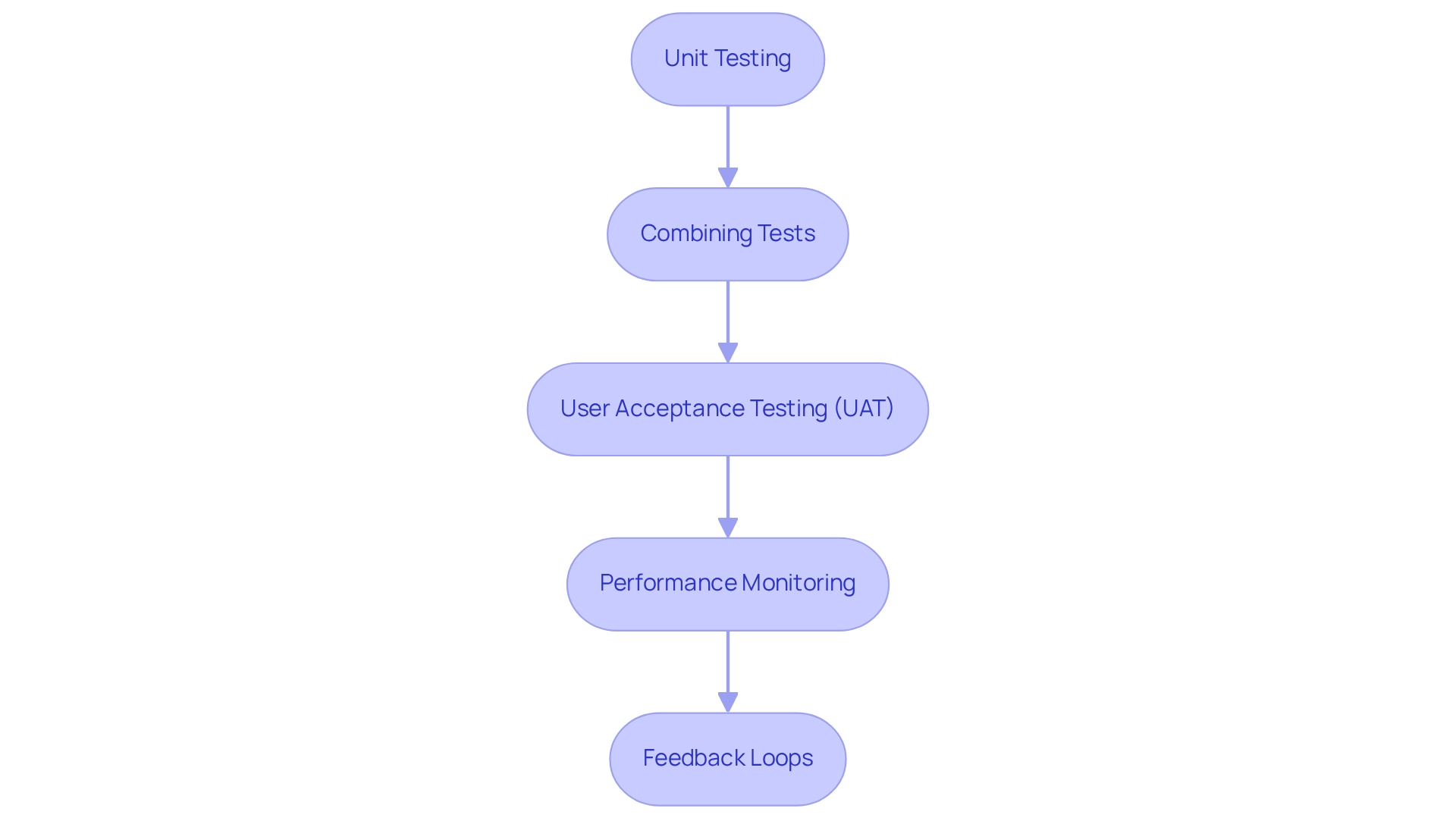
Best Practices for Maintaining Integrated Legacy Systems: Future-Proofing Your Integration
To ensure your integrated older platforms are prepared for the future, it is imperative to apply the following best practices:
-
Regular Updates: Maintaining both legacy and modern frameworks is essential for ensuring compatibility and security. Statistics indicate that organizations implementing regular updates experience a 30% enhancement in performance, significantly reducing downtime and improving user satisfaction. Our specialized unification services, including enterprise architecture and project management, facilitate the efficient integration of legacy systems, ensuring your platforms remain robust and secure.
-
Documentation: Thorough documentation of the integration process, system architecture, and modifications over time is crucial. This practice not only aids in troubleshooting but also preserves knowledge within the organization, facilitating smoother transitions during personnel changes. We emphasize the importance of comprehensive documentation as part of our customer-centric solutions, helping businesses maintain clarity and continuity.
-
Training: Continuous education for staff is vital to ensure comfort with the integrated frameworks. Empowering employees with the knowledge to troubleshoot issues as they arise can lead to a 25% reduction in resolution times, thereby maintaining operational efficiency. We support this by offering customized training programs that promote a culture of adaptability and ongoing learning, enabling organizations to focus on integrating legacy systems effectively.
-
Scalability Planning: Designing the connection with scalability in mind allows for future growth and the seamless addition of new technologies. Organizations prioritizing scalability are better positioned to adapt to evolving market demands and technological advancements, ensuring long-term viability. Our hybrid connectivity platform is specifically crafted to enable this scalability, connecting traditional infrastructures with contemporary expectations.
-
Continuous Monitoring: Implementing continuous monitoring practices is key to identifying and addressing performance issues proactively. By maintaining 24/7 availability for essential connections, companies can ensure that their operations remain efficient and effective, ultimately driving improved business results. Our integration solutions include robust monitoring tools that enable organizations to manage complexity and achieve better outcomes.
Implementing these best practices not only mitigates risks associated with older technologies but also fosters a culture of adaptability and ongoing learning, allowing organizations to leverage their current technologies effectively. As illustrated in the case study ‘Seizing the Opportunity,’ companies embracing a comprehensive approach to digital transformation—addressing fundamental challenges while strategically investing in technology and integrating legacy systems—can optimize the capabilities of their integrated frameworks and foster innovation. This case study demonstrates how Avato’s services have empowered organizations to enhance operational efficiency by integrating legacy systems and overcoming related challenges.
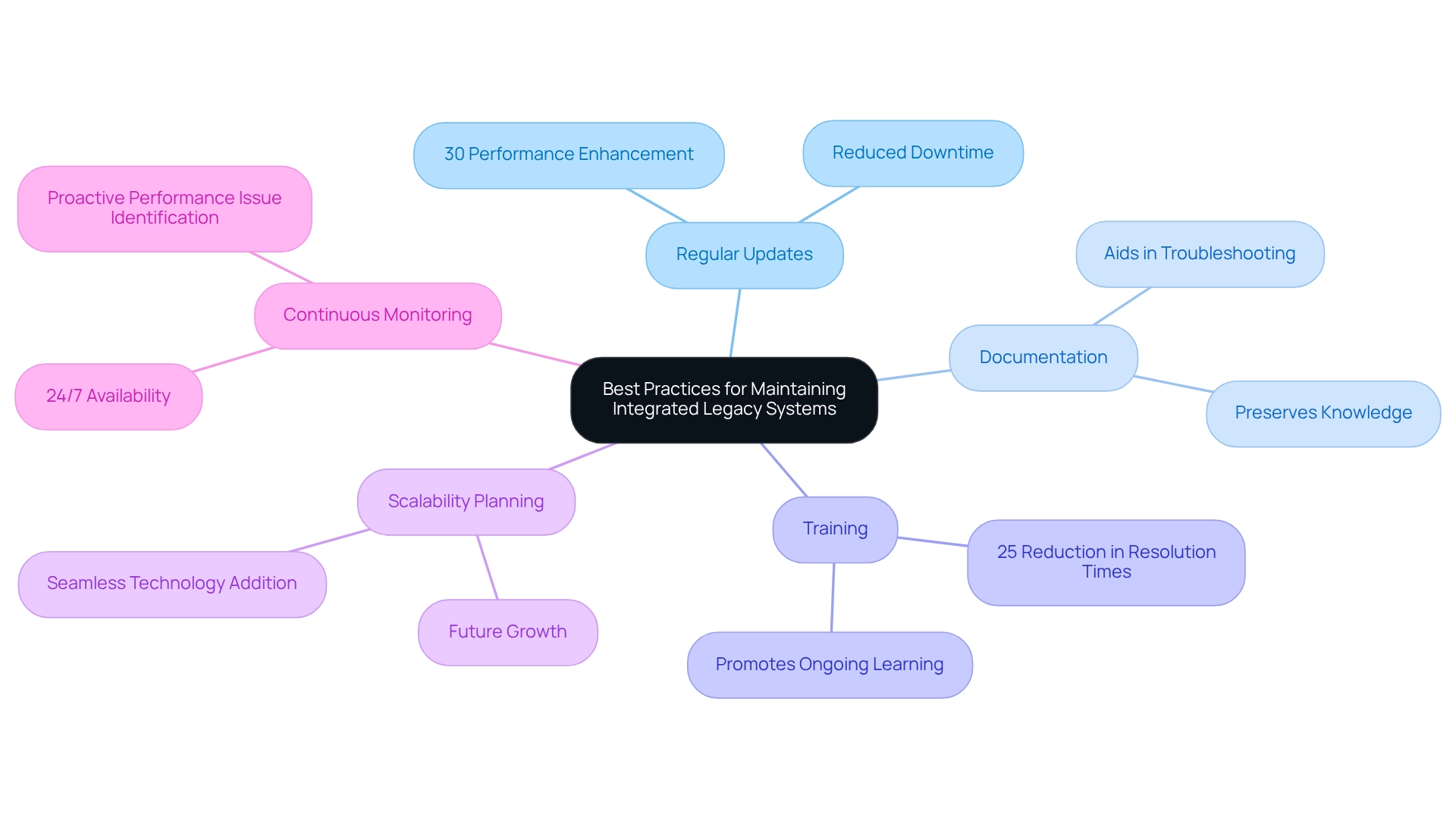
Conclusion
Integrating legacy systems represents a complex yet critical endeavor for organizations aiming to excel in an increasingly digital landscape. Understanding these systems is paramount, as they serve a dual purpose—both challenges and assets. By effectively integrating legacy systems, organizations can unlock valuable data, enhance operational efficiency, and ultimately foster innovation in sectors such as banking and healthcare.
Key challenges, including data incompatibility, security risks, high maintenance costs, and limited scalability, must be tackled through strategic approaches. Leveraging tools and technologies, such as Avato’s Hybrid Integration Platform, is essential for facilitating seamless integration. Employing strategies like API integration, middleware solutions, and phased migration can significantly ease the transition process while ensuring operational continuity.
Furthermore, a structured, step-by-step approach to integration—beginning with assessment and objective definition, followed by the selection of appropriate tools and rigorous testing—enables organizations to effectively navigate the complexities of legacy systems. Continuous monitoring and regular updates are crucial for maintaining system integrity and performance, thereby future-proofing the integrated solutions.
As the digital landscape evolves, organizations must recognize the imperative of modernizing their legacy systems. By adopting best practices and leveraging the right technologies, they can transform potential obstacles into opportunities for growth and innovation. Embracing this journey not only enhances operational capabilities but also positions organizations to meet the demands of an ever-changing market landscape, ultimately leading to sustained success.

